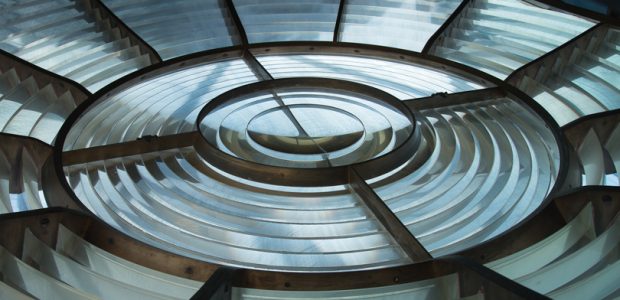Critique Submissions
This page contains selected August 2001 submissions from photographers who wished to have their photographs reviewed by the publisher of this site,Michael Reichmann, as well as by other readers on ourDiscussion Forum.
The winner this month’s contest and a free issue of theVideo JournalisMiles Hecker.
For details on how to submit a photograph for critique please see theCritique / Contestpage.
Miles Hecker
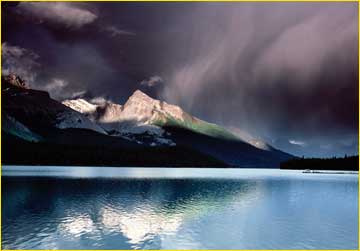
Miles Hecker
Casper, Wyoming, USA
mhecker@acad.cc.whecn.edu
Contax Aria 35-70mm Zeiss lens, Provia 100F, Singh-Ray 3 stop neutral density filter, Nikon LS8000 scanner
Maligne Lake, Alberta Canada
Interesting landscape photos are the result of paying attention to both the geography and weather conditions.
On a recent trip to the Jasper, Alberta area it became apparent that a cold front was about to move through at sunset. The open vistas of Mailgne Lake proved to be a good spot to observe the contrast between air, rock and water in the light of the setting sun. The incredibly soothing glow present in the waters of the lake provided a stark contrast to the violent events unfolding above.
Michael’s Critique
Miles’ photographer is exceptional. The light, location and timing have come together in a way that doesn’t happen all that often for landscape photographers. It’s been said that "luck" is preparedness in the face of opportunity. This must have been Miles’ lucky day. Well seen and executed.
You can add your own comments on Miles’ photograph on the Critique section of ourDiscussion Forum.
Andrew McMinigal
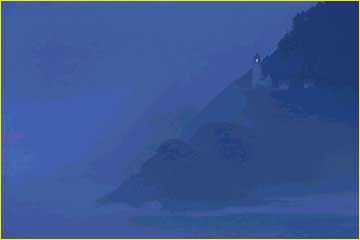
Andrew McMinigal Delta, BC , Canada mcminigal@yahoo.com Canon T-90, Tamron 80-210mm zoom lens, Kodachrome 64 film, tripod. Exposure not recorded. Taken on a foggy day in northern California in 1990, with a cokin blue filter held in front of the lens for added effect.
Michael’s Critique
This image immediately captured my attention. The mood of a foggy coastline is perfectly captured. The JPG compression is too high and so there’s some artifacting, but I’m sure that a print would be very enjoyable to view.
You can add your own comments onAndrew’s photograph on the Critique section of ourDiscussion Forum.
Bob Rosenstein
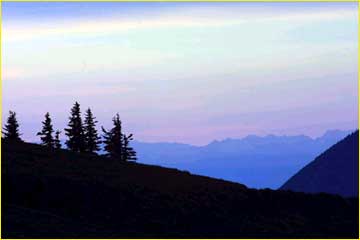
Bob Rosenstein
Decatur, Illinois USA
rrosenstein@home.com
This was taken with a Canon D30 in the Olympic National Park, Washington in the morning hours. Exposure data includes manual mode with 0.5 second shutter speed, f/19 at ISO 100. Used a Canon 100-400L lens, with focal length at 400. Shot in Raw mode.
Michael’s Critique
We’ve all seen this image before. Most of us have shot it before. Well, maybe not this exact location, but you know what I mean. The silhouetted trees, the distant blue hills, the pinky sky.
Bob has done an "OK" job with it but the subject matter has become a bit of a clichÈ and it needs to be seen in new ways to capture our attention. That’s the challenge of contemporary landscape photography.
You can add your own comments onBob’s photograph on the Critique section of ourDiscussion Forum.
Paul Silk
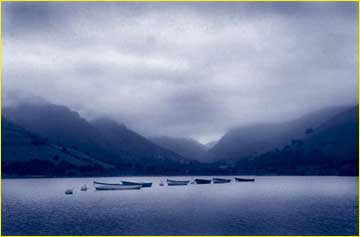
Paul Silk
Westbromwich, England
snaphappy@blueyonder.co.ok
Kodak DC4800 Converted to black & white & tritoned Talylyn North Wales
Michael’s Critique
Photographers must be in their "blue period" this month given the first three entries.
Paul’s submission is a very strong and pleasing image. The row of boats nicely completes the composition and there’s enough texture in the sky to prevent it becoming a uniform mass. The glow on the water surrounding the boats adds the final touch.
You can add your own comments on Paul’s photograph on the Critique section of ourDiscussion Forum.
Jose Maria Farfaglia
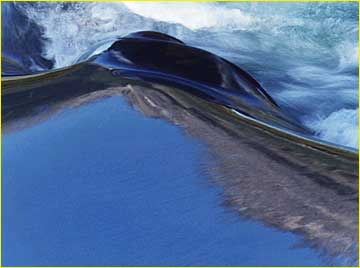
Jose Maria Farfaglia
Trelew, Chubut, Argentina
jmfarfa@infovia.com.ar
Technical data: Chromiun Water. Canon EOS Elan IIe, 28-105 @ 105, 1/15 f:11, shoot near Mascardi Lake in Patagonia.
Michael’s Critique
This an eye catching rendition of flowing water, though this type of submission has become quite common. But Jose has created a composition that works well and is in keeping with the "blue" theme that is developing this month.
You can add your own comments on Jose’s photograph on the Critique section of ourDiscussion Forum.
David Hansberry
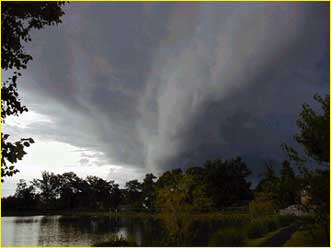
David Hansberry
Virginia Beach, USA.
Dhansberry1@home.com
This picture was taken with a Epson Photo PC 750Z digital camera. No digital alterations have been done. This is a picture I call "The Front". It was a massive storm front that rolled in from the west and just took over the sky.
Michael’s Critique
This is a fascinating view of a dramatic weather system. It’s unfortunate that David wasn’t in a more interesting position to photograph it because its context does little to enhance the image.
As discussed in previous months, a successful landscape photograph needs to do more than record an interesting locale or light condition. All of the pieces need to come together, including light, subject matter, composition and the photographer’s unique "vision".
You can add your own comments on David’s photograph on the Critique section of ourDiscussion Forum.
Youssef Ismail
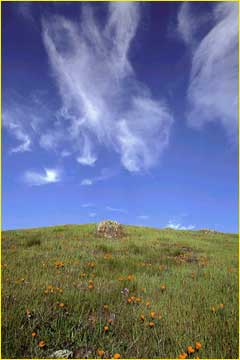
Youssef Ismail
San Jose, CA, USA
ismaily@ssd.loral.com
Taken with Nikon F4s, Nikon 24mm F/2 AIS lens, on Kodak E100SW on a tripod with cable release and mirror locked up. Exposure f11 @ 1/125, spot metered clouds + 1 1/2 stops open. ICG Drum scanned, Levels and Selective Color correction in PhotoShop 6 to remove cyan/magenta cast in clouds.
Taken in Mid March, 2001 at Mount Diablo State Park in SF Bay Area in California during the poppy bloom on the mountain. Even though I broke the cardinal rule of taking landscapes in full blazing light, I tried for a composition which used the flowers as a lead in to the central boulder and from that boulder a jump off into the blue sky and clouds. I think it portrays the essence of Spring quite well and gives me a feeling of joy and breathless freedom as I jump into the clouds.
Michael’s Critique
Giving prominence to the sky and lovely cloud formations was very well considered and has created a fine composition. Youssef mentions "breaking the rule" about not shooting in full sunlight. This is a misconception. The current vogue of shooting landscapes in early morning and late in the day is just that, a trend. There’s no reason why exciting images, like this one, can’t be made at mid-day. It’s just tougher.
You can add your own comments on Youssef’s photograph on the Critique section of ourDiscussion Forum.
Andreas Dahlem
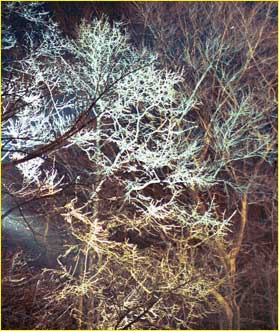
Andreas Dahlem Munich, Germany & Glasgow, Scotlandandreasdahlem@gmx.netCanon EOS 3, EF 100-400mm IS USM lens, Provia 100, tripod, scanned with a Minolta Dimage Scan Elite
This photograph was taken in Spring 2000 whilst staying with my parents in Munich during my university holidays. I had the chance to borrow some equipment from a local camera shop, where I used to work. I intended to test the equipment and take some nocturnal architecture photographs, which I like for their eerie atmosphere. On my way back home from MunichÃs city centre, I saw these trees which were illuminated by the floodlights of a peace monument. The long exposure caused a slight colour shift, which makes the branches look surreal. To make the image look even more abstract I slightly cropped it. I like this photograph, because I enjoy abstract art, and this image set off one of my current projects. It is the enigmatic character of abstract photographs that fascinates me, and which inspires the viewersà fantasies, as they are not straight forwardly aware of the pictureÃs subject. Hence I avoid to name such images, which would only limit the viewers’ imagination.Michael’s Critique
I am including this photograph because I’d like to use it to make a point about the necessity of the artist/photographer separating his emotional response to a certain image from the necessity of adopting a more objective viewpoint.
Clearly Andreas feels strongly about this photograph. But, the reality is that it is a weak and somewhat messy composition. Abstract photographs can be charming and alluring, but they must adhere to the same principals of good composition as do more literal images.
You can add your own comments on Andreas’ photograph on the Critique section of ourDiscussion Forum.
Thomas W. Earle

Thomas W. Earle Pendleton, Oregon (USA) twade@bmi.net
This photograph was taken at sunset from Cabbage Hill just east of Pendleton, Oregon. The ominous sky is the result of a dying thunderstorm. I waited and hoped for a lightning strike, but gave up since my light was fading fast. Fuji Provia 100F @ ASA 100, 1/2 min @ f/22, Wisner 4×5 Expedition, Nikor 300 MMichael’s Critique
I’ve been looking at Thomas’ photograph for a while, trying to decide why I don’t find it completely satisfying. Part of the reason is because we’ve seen this so many times before.
Nevertheless it’s a strong photograph. I wonder though if it had been framedwithoutthe sun, as a vertical, with just the clouds and the thin sliver of hot orange sky if it might not have been a more unique visualization.
You can add your own comments on Thomas’ photograph on the Critique section of ourDiscussion Forum.
Dennis J McKenzie
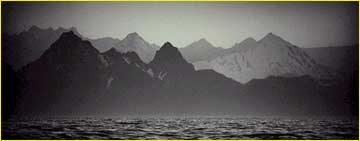
Dennis J McKenzie
Wasilla, Alaska
djmckenzie@webtv.net
Technical data: Nikon F4, 24mm-120 Nikon zoom lens, Provia F100 pushed to 200 ISO. Hand held resting on boomgallows.
Situation: While sailing back to Seward last year in the lowering sun. The mountains and sea where highlighted in very nice light. I have worked this image in PS as color (very pastel colors as on the slide) and as a duo tone and now as toned B&W as seen here. I am trying in my photo work to give an impressionist feel to the land/seascape I see before me. Because for me that’s the way I feel the image has the most power for me.
Michael’s Critique
I appreciate what Dennis is trying to accomplish with this photograph, and he’s close. But, I feel that the vignetting effect doesn’t really add any value to the image. The monochromatic mountainscape is lovely enough without the artificiality of the "binocular" perspective.
You can add your own comments on Dennis’ photograph on the Critique section of ourDiscussion Forum.
Paul McKeown
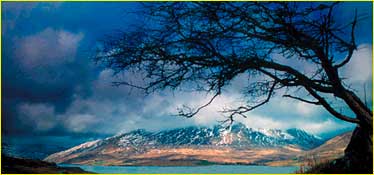
Paul McKeown
Baltimore, MD USA/ Glasgow, Scotland
Mysticmusic@cs.com
Canon EOS 50E, 17 – 35mm, Fuji Sensia II. Cropped and sharpened on PC.
Taken in November in Connemara, W coast of Ireland, on a bright stormy day. There are a lot of these trees, all bent in the direction of the prevailing winds, or hiding behind dry stone walls, all clinging to the soil with great tenacity.
Michael’s Critique
Light, weather and subject matter don’t get much better than this for photographers. Paul has done a good job overall but the image misses being great. I find that the left of the frame doesn’t add much to the composition. I feel that a framing more to the right and squarer could have been more convincing.
You can add your own comments on Paul’s photograph on the Critique section of ourDiscussion Forum.
Steve Bromley
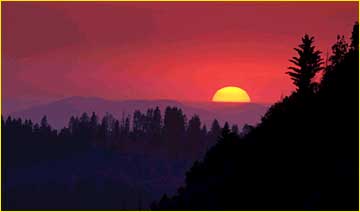
Steve Bromley
Austin, TX USA
Sbrom@austin.rr.com
"Sunset – Moro Rock" Sequoia National Park – July, 2001
Canon Elan IIe, 100-400L lens w/1.4X teleconverter, f8. Fuji Velvia film. Scanned with Nikon 4000ED, adjusted in Photoshop to match the original.
This was my first visit to Sequoia National Park. A great photo feast! A climb up the 400 steps of Moro Rock rewarded me with this sunset, exposed to maximize the layering effect in the receding hills. This is the best shot of several, with the sun at varying degrees above and below the horizon.
Michael’s Critique
A lovely photograph. Steve has nailed the composition as well as a potentially tricky exposure. Unfortunately the file submitted has too high JPG compression so the smoothness of the tonalities has been compromised, but otherwise it’s a very sweet image.
You can add your own comments on Steve’s photograph on the Critique section of ourDiscussion Forum.
JeffreyGoggin
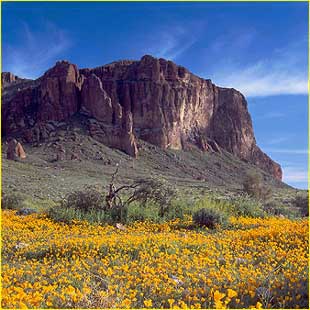
Jeffrey Goggin
Scottsdale, Arizona USA
audidudi@mindspring.com
This image was shot earlier this year at the Lost Dutchman State Park east of Phoenix, AZ. It was shot with a Minolta Autocord on Provia 100F through a Singh-Ray A13 warming filter. Although I like this image on its own, it was shot as the rightmost frame of a three-part series that I plan to stitch together to form a panorama. I find the foreground a little distracting but can’t bring myself to crop away any of the desert poppies…
Michael’s Critique
Square format images have been discussed recently on the Discussion Forum. I find myself "seeing" square a great deal of the time when I’m shooting 6X6cm.
Jeff has created a very appealing composition. Normally the "weight" of the mountainside in the center of the frame would unbalance the image, but the strong colour contrast of the yellow poppies at the bottom of the frame creates a needed counterbalance. The contrast with the blue sky at the top of the frame also completes the compositional counterbalances. Nicely seen.
You can add your own comments on Jeff’s photograph on the Critique section of ourDiscussion Forum.
Steve Fowler
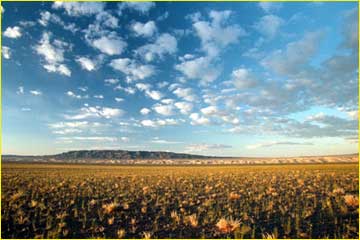
Steve Fowler
Wethersfield, CT, USA,
tongba@home.com Canon EOS Elan IIe, 24-85 Canon USM, Fuji Film, polarizer Photo was taken in the Gobi Desert, southern Mongolia in July 2000 at sunset. Mongolia is known as the ‘Land of Blue Sky’. I was attracted by the late afternoon colors and the vastness/remoteness of the scene. Film was developed by Kodak and put onto PictureCD. I made minor adjustments in Photoshop Elements.
Michael’s Critique
The quality of the light is what "makes" this photograph. My only problem with it is that the horizon line is distorted. This can easily be fixed in Photoshop. Otherwise, nicely executed.
You can add your own comments on Steve’s photograph on the Critique section of ourDiscussion Forum.
Jed Buchwald
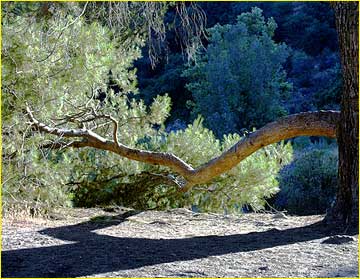
Jed Buchwald
buchwald@hss.caltech.edu
Taken several weeks ago in Eaton Canyon, Altadena, CA at sunset. Canon D30, 1/30 at f16, ISO 200, 28-135 IS lens at 41mm, RAW, processed in Photoshop
6.0
Michael’s Critique
The subject is fascinating and Jed has successfully chosen a strong cross-light situation to make the shadow of the tree limb a dominant component. The fact that there is detail in the background shadowed area adds additional interest.
Interestingly, the first thing that I did while looking at the photograph was to flip it horizontally so that it "reads" left to right. I feel that it works better that way, though of course it’s a distortion of reality.
You can add your own comments on Jed’s photograph on the Critique section of ourDiscussion Forum.
Ken Cravillion
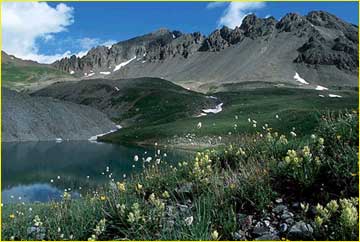
Ken Cravillion
Oshkosh WI USA
kcravillion@kgcphoto.com
Taken with a Canon EOS-1V HS, TS-E 24L, Fuji Provia F, Gitzo G1325 This is an image of Wright Lake taken in Yankee Boy Basin near Ouray, CO this past July. The flowers in the foreground are Indian Paintbrush. More images can be seen athttp://www.kgcphoto.com
Michael’s Critique
A remarkable location very well photographed. But, once again, as in the photograph immediately above, the first thing I wanted to do was flip the image left to right so that the flowers lead down to the lake on the right, not the left.
It could be that I woke up in the "bizarro universe" this morning and somehow the world turned into a mirror image. Seriously though, for viewers whose written language reads left to right some images "read" more naturally if the subject matter causes the flow of the eye over the image to similarly be left to right. As it is, because of this both of these images have a "tension" that I feel works counter to their best interest.
You can add your own comments on Ken’s photograph on the Critique section of ourDiscussion Forum.
Larry Adkins
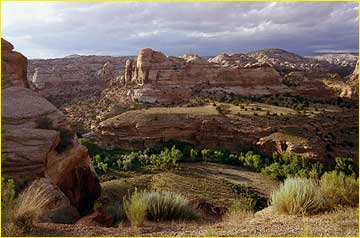
Larry Adkins Tustin, Californialarryadkins2@msn.com This photograph was taken from Utah state highway 12 in the new Grand Staircase Escalante National Monument. It was on July 31, 2001, late in the afternoon, with the sun getting low. This was my first trip along this particular stretch of highway, and I found the scenery breathtaking. The camera was a Nikon 6006 (24mm – 80 mm zoom lens) loaded with Kodak Royal 200 negative color film. There is no computer manipulation here other than contrast optimization.
Michael’s Critique
I drove this stretch of highway earlier this year as well, and agree with Larry that it really is quite remarkable. His photograph nicely captures the ambiance of the scene but there’s no special insight or unique perspective offered. Possible if the framing had place the foreground sage more prominently it would have drawn the viewer closer. As it is there isn’t enough "dimensionality" to make the viewer feel part of the landscape.
You can add your own comments on Larry’s photograph on the Critique section of ourDiscussion Forum.
Sheri Patterson
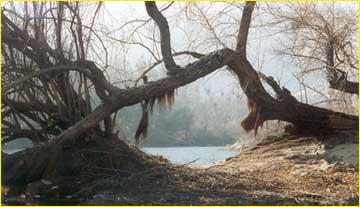
Sheri Patterson Weaverville, CA USASheri@digital-cuisine.com Photo taken on: 1/02/99 at Kern Canyon, Kern County, CA Time taken: early afternoon Photo taken with: Minolta Vectis S-1, 28-56mm lens, 1:4(22)-5.6 Film used: Fuji, 200 APS Digital enhancement: none My husband and I were traveling through Kern Canyon and stopped to go rock hunting near the river. I saw this fallen tree and was inspired by the moss hanging from it. I took a shot while standing behind the tree, but did not realize its true beauty until I got down on my knees and shot through it . To me, it was a beautiful window to the river and bank at the other side. I hope you enjoy it.Michael’s Critique
The framing of this image combined with an interesting subject is good, but unfortunately the lack of interesting light makes it fall short. It needs fog, strong cross-light, something… to make it rise above the ordinary.Locationandtiming. I’m working on an essay about this which should be online in a few days. The shot also cries out for the crisper definition of a larger format.
You can add your own comments on Sheri’s photograph on the Critique section of ourDiscussion Forum.
David Mantripp
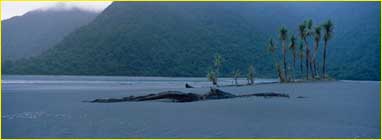
David Mantripp
Lugano, Switzerland
david.mantripp@bluewin.ch
Hasselblad Xpan, 45mm lens, exposure / aperture unrecorded, Fuji Provia 100F , Scanned at 4000ddpi on Microtek ArtixScan 4000t , minimal level adjustment in Photoshop
This photograph was one of several I took on a sand bank near the mouth of the Haast River, on the West Coast of the South Island, New Zealand. The sand bank was notable by the clump of palms sprouting from it (and by the vicious sand flies who ensured that a price was paid for the photos). Time, around 8pm, Jan 1st 2001.
Michael’s Critique
The most striking thing about this photograph is the almost surreal look of the palm trees which is heightened by the monochromatic blue cast. Very mysterious. David has wisely allowed the little bit of sky and cloud to balance the left side of the composition.
You can add your own comments on David’s photograph on the Critique section of ourDiscussion Forum.
Pascal Jappy
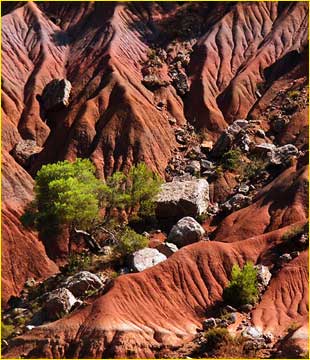
Pascal Jappy
Aubagne, France
pascal.jappy@hummingbird.com
Picture taken with a Minolta Dimage 7 camera @200mm.
The location is Aix-en-Provence, France. The red soil around the montagne Ste Victoire has inspired French painters throughout the century, but I’d never been there until a few days ago, although I live a few miles away. The picture was shot at midday under a harsh light and I have no filter for this camera yet, so I tried to tame and saturate the highlights in Photoshop a little bit. Apart from that, it’s strait out of the camera.
Michael’s Critique
This looks so much like red-rock country in the American southwest that it’s uncanny. As Pascal says, the harsh mid-day sun doesn’t do much to help. I like the image, though I feel that the area at the bottom of the frame is distracting. Have a look at it croppedthis wayinstead.
You can add your own comments on Pascal’s photograph on the Critique section of ourDiscussion Forum.
StÈphane Bosman
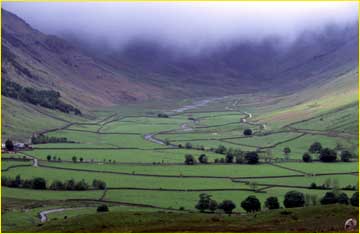
StÈphane Bosman Bruxelles/Belgiumstephane.bosman@chello.be EOS 3, 100mm f2 EF, tripod, Provia 100F At the top of a hill, that view sprang to our eyes. framing was not obvious because the landscape itself was to wide to be presented effectively in one picture. Finally, I chose to show that part, for the colors and the serenity that comes out of it.
Michael’s Critique
This is a gentle contemplative image. The soft light and low hanging cloud present an appealing mood. I’d wish for somewhat more interesting cross light, or a strong foreground subject, but failing that it’s a pleasant photograph. As with the one immediately above I feel that the area at the bottom of the frame is distracting and unnecessary. Have a look at it croppedthis way.
You can add your own comments on StÈphane’s photograph on the Critique section of ourDiscussion Forum.
Andy Biggs
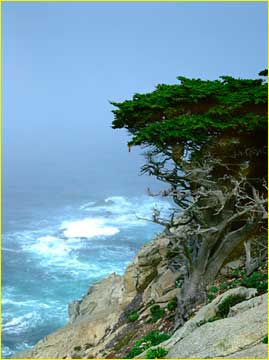
Andy Biggs
San Francisco Bay Area, CA
abiggs@tvmcapital.com
Canham DLC, 4×5" Fuji Velvia QuickLoad, Rodenstock APO Sironar-S 210mm lens
Point Lobos, CA
This was my absolute first shot taken with my new Canham DLC 45 large format camera. Definitely a beast to work with, but the results should get better with time and practice. And practice. And practice. A tricky image to all get into focus, and could really use movements. Tricky exposure, as I was trying to protect the highlights in the water, without losing detail in the shadows.
Michael’s Critique
While I understand Andy’s enthusiasm I’m afraid that the photograph doesn’t hang together for several reasons. The burned out highlights in the water are certainly a distraction. Also, the composition just doesn’t work. There’s too much blank sky and the tree feels chopped off, making the whole composition unbalanced.
You can add your own comments on Andy’s photograph on the Critique section of ourDiscussion Forum.
Michael de Keyser
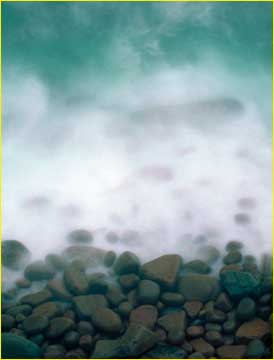
Michael de Keyser, NJ
mikedekeyser@hotmail.com
Canon Elan 2E, Sigma 70-200, Fuji Velvia scanned to a PhotoCD and then adjusted levels in Photoshop applied 100%, radius 1, threshold 0 in unsharp mask
Taken at Acadia National Park. the point of view is from a cliff looking almost straight down the rocky shoreline and a relatively long exposure to blur the water splashing at the shoreline.
Michael’s Critique
This photograph has a fresh point of view. I like that there’s no sense of scale. I could be looking down 20 feet, or 200. The total effect is ethereal and I appreciate that the highlights in the water haven’t burned out, something that would be all to easy to have happen.
You can add your own comments on Michael’s photograph on the Critique section of ourDiscussion Forum.
James L. Champa
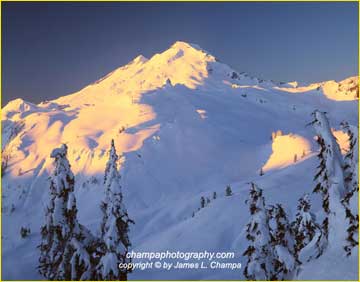
James L. Champa
Port Orchard, Washington,USA
jlc@champaphotography.com
Pentax 67, 75mm, 81B, f/22, 1second
In pre-dawn darkness, I skiied cross country beneath the south flank of Table Mountain, Mt. Baker Wilderness, to photograph Mt. Baker. The temperature was 8 degrees below zero Fahrenheit. The Pentax battery cable snaked its way to the battery buried deep in my parka during the process! I shivered and hopped up and down trying to keep warm while waiting for the sunrise. When the sun finally descended Baker’s flanks, I made several exposures, adjusting aperture and shutter speed each time. Then I celebrated the glorious sunrise by gulping down a mug of hot cocoa which I had stashed in my daypack.
My homepage: www.champaphotography.com
Michael’s Critique
This is a well executed and well composed landscape image. But I must be frank and say that my first impulse was to ignore it because of the included web site promotion and copyright notice. Instead I’m including it here so I can step onto my soapbox for a moment.
All too often photographers deface their work on the Net by overwriting the image with copyright text. For the life of me, I can’t understand why. A 3X5" or even a 6X9" online image at 72 dpi can not be stolen off the Web for any worthwhile purpose; not even for use as a screensaver. What’s more, the JPG compression used renders it useless for any serious print application. So why deface it with a copyright notice?
When I visit sites that display their photography this way I rarely stay for more than a quick glance. I regard it as a dishonour to the integrity of the images.
You can add your own comments on James’ photograph on the Critique section of ourDiscussion Forum.
Geoff Eldridge
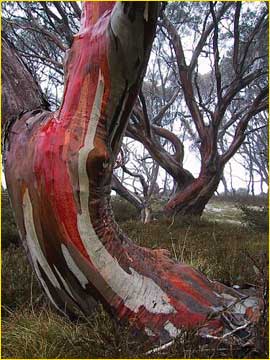
Geoff Eldridge
Sydney, Australia
geoff@elj.com
Canon IXUS with Compact Flash Card on a tripod.
This photo was taken on a recent winter trip to the Australian Snowy Mountains. The exact location is on the Porcupine Trail just behind Persiher Valley Ski Resort. This photo was taken around midday in very cold (-2 deg C) and windy conditions. Light sleet and rain had been falling and misty clouds swept the landscape. This particular tree I had noticed six months earlier on summer trip to the mountains. The red and orange effect on the bark is a rare and natural occurrence from what I can tell. I have been told it might be chlorophyll withdrawing from the bark, as it dies, leaving the same colours as deciduous leaves. This image is slightly cropped from the original with some sharpening. A largeruncropped versionis available.
Michael’s Critique
A fascinating subject, nicely handled. Geoff’s composition, with the coloured tree to the left of frame and the background trees to the right almost works. It’s always my preference to frame or at least crop as tight as possible. To see what I mean have a look at it croppedthis way.
You can add your own comments on Geoff’s photograph on the Critique section of ourDiscussion Forum.
Jean-Paul FalguiÃres
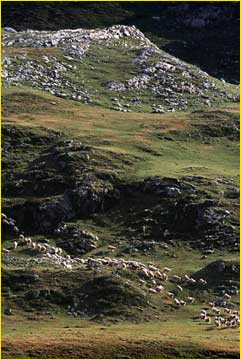
Jean-Paul FalguiÃres Talence, Francewww.imagesdespyrenees.com
Canon EOS50 zoom Sigma 28-70 f 2.8
Photographe amateur, amoureux de la nature, Je vous soumet cette image rÈalisÈe il y a quelques jours dans les PyrÈnÈes (VallÈe d’Ossau) en fin de journÈe. Elle fait partie de mon site consacrÈ aux PyrÈnÈes Michael’s Critique
Jean-Paul’s photograph from the Pyrenees mountains takes a moment to comprehend. Then you see the sheep at the bottom of the frame and how they echo the form and colour of the rocks further up the hillside. The black sky adds an element of mystery and drama.
You can add your own comments on Jean-Paul’s photograph on the Critique section of ourDiscussion Forum.
All Photographs on This Page are the Copyright of Their Respective Photographers
All Rights are Reserved
You May Also Enjoy...
“Middle Of The Day Photography” Is Not Always Bad
FacebookTweet It is “De Rigueur” for serious landscape photographers on location to get up before dawn, having previously scouted the location, so as to arrive
